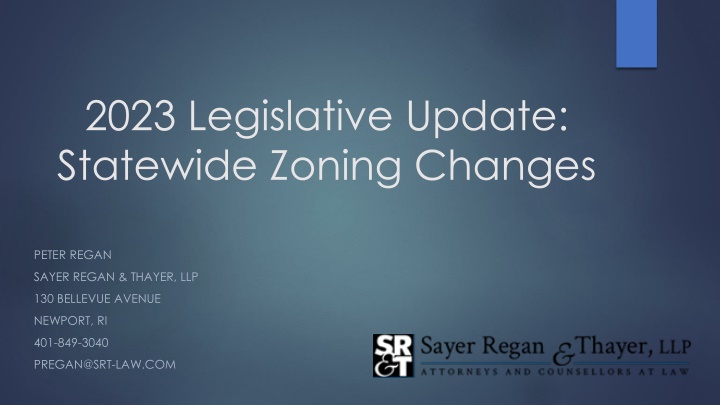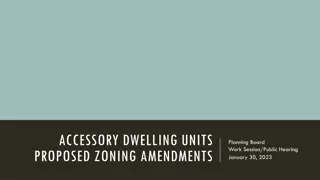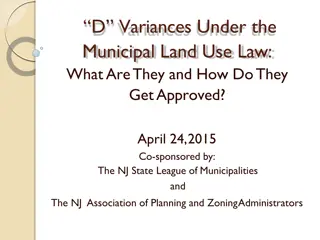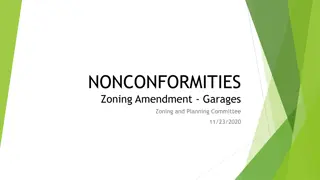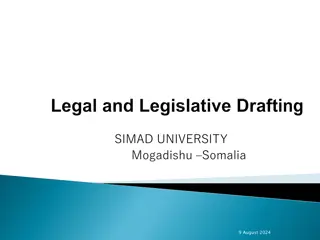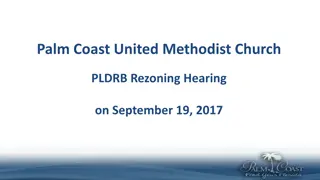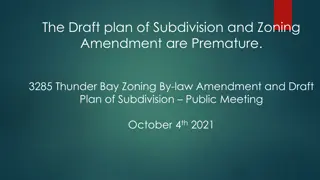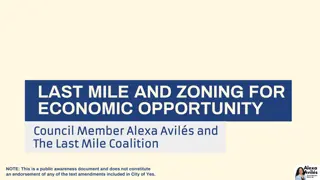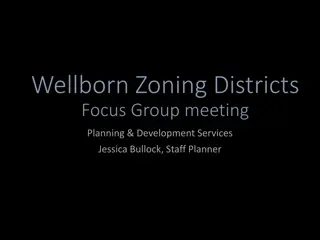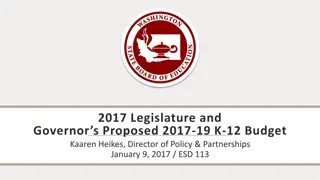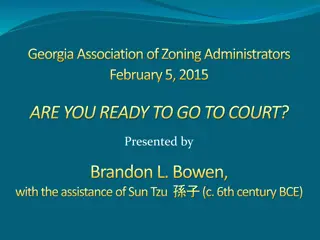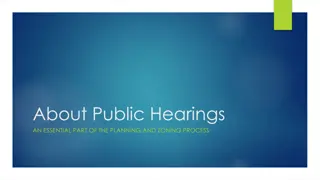2023 Legislative Update: Statewide Zoning Changes Overview
The 2023 Legislative Session in Rhode Island brought significant changes to zoning laws, aiming to boost housing construction and streamline the land development process, benefiting developers and property owners. Government officials praise the bills for enhancing communities, cutting red tape in housing development, and creating more affordable housing options for Rhode Islanders.
Uploaded on Mar 15, 2025 | 1 Views
Download Presentation

Please find below an Image/Link to download the presentation.
The content on the website is provided AS IS for your information and personal use only. It may not be sold, licensed, or shared on other websites without obtaining consent from the author.If you encounter any issues during the download, it is possible that the publisher has removed the file from their server.
You are allowed to download the files provided on this website for personal or commercial use, subject to the condition that they are used lawfully. All files are the property of their respective owners.
The content on the website is provided AS IS for your information and personal use only. It may not be sold, licensed, or shared on other websites without obtaining consent from the author.
E N D
Presentation Transcript
2023 Legislative Update: Statewide Zoning Changes PETER REGAN SAYER REGAN & THAYER, LLP 130 BELLEVUE AVENUE NEWPORT, RI 401-849-3040 PREGAN@SRT-LAW.COM
Overview During the 2023 Legislative Session, the General Assembly passed a series of bills amending the Rhode Island Zoning Enabling Act The intent of these bills was to encourage the construction of additional housing inventory, and to streamline and bring uniformity to the land development process The effect goes beyond housing and creates more opportunities for developers and property owners to maximize property value
What Governments Saying The bills we are signing into law today won t just build houses they ll strengthen communities. From prioritizing transit hubs in our development strategies to transforming underutilized commercial spaces into thriving homes, this legislative package will help create a space for everyone in Rhode Island[.] Lt. Governor Sabina Matos The bills will help cut through a great deal of the frustrating red tape that is standing in the way of the development of new housing. The legislative package will move housing forward for Rhode Islanders in all our communities who need and deserve safe and affordable homes. Speaker K. Joseph Shekarchi This budget cycle and legislative session was a major step in the right direction for Rhode Island in terms of creating more affordable accessible housing for all[.] I want to thank the General Assembly for their leadership and for recognizing the importance f continuing to meet the needs of the housing market here in the Ocean State. Governor Dan McKee
Agenda Critical 2023 Legislative Changes Adaptive Reuse New rules for Substandard lots Zoning Modification process Changes in standards for variances and special use permits Changes that streamline the process for Land development projects and subdivisions
Adaptive Reuse (H-6090A/S-1035A) [A]daptive reuse for the conversion of any commercial building, including offices, schools, religious facilities, medical buildings, and malls into residential units or mixed use developments which include the development of at least fifty percent (50%) of the existing gross floor area into residential units, shall be a permitted use[.]
Adaptive Reuse (H-6090A/S-1035A) [A]daptive reuse developments [shall be exempted] from off-street parking requirements of over one space per dwelling unit. Where project is: (a) limited to the existing footprint; (b) includes 20% low- and moderate-income housing; and (c) has access to public sewer and water (or access to adequate private water), the municipality cannot limit density to less than 15 units per acre. For all other adaptive reuse projects, the residential density permitted in the converted structure shall be the maximum allowed that otherwise meets all standards of minimum housing and has access to public sewer and water service or has access to adequate private water[.] While allowed by right, most adaptive reuse projects will still go through Development Plan Review.
Adaptive Reuse (H-6090A/S-1035A) Previously underutilized properties have new value Examples An office or retail building in a commercial district with lagging demand might previously sit vacant. This legislation allows that vacant building to be converted to high density housing or mixed-use, allowing a property owner/developer to maximize value. A parish seeing a decreasing number of parishioners may seek to dispose of unneeded churches. This legislation makes such properties significantly more valuable. A former school building in a residential district might previously require significant relief from a Town or City Council to develop. Now: a clear pathway exists to redevelopment.
Substandard Lots (H-6059/S-1032) [A] substandard lot of record shall not be required to seek any zoning relief based solely on the failure to meet minimum lot size requirements of the district[.]
Substandard Lots (H-6059/S-1032) The setback, frontage, and/or lot width requirements for a structure under this section shall be reduced and the maximum building coverage requirements shall be increased by the same proportion as the lot area of the substandard lot is to the minimum lot area requirement of the zoning district in which the lot is located.
Substandard Lots (H-6059/S-1032) Example Assume a 8,000 SF lot in an R-10 District (10,000 SF of land area required) in Middletown, where 25% lot coverage is allowed and 25 front setback is required The lot is substandard in size by 20% Therefore, the applicable setbacks are reduced in size by 20% In addition, the allowable lot coverage is increased by 20%, from 25% to 30%
Substandard Lots (H-6059/S-1032) Pre-January 1, 2024, the lot is allowed 25% lot coverage (2,000 SF) and the front setback must be at least 25 As of January 1, 2024, the lot is allowed 30% lot coverage (2,400 SF) and the required front setback is reduced to 20
Variances (H-6059/S-1032) (1) That the hardship from which the applicant seeks relief is due to the unique characteristics of the subject land or structure and not to general characteristics of the surrounding area; and is not due to a physical or economic disability of the applicant[.] (2) That the hardship is not the result of any prior action of the applicant and does not result primarily from the desire of the applicant to realize greater financial gain; and (3) That the granting of the requested variance will not alter the general character of the surrounding area or impair the intent or purpose of the zoning ordinance or the comprehensive plan upon which the ordinance is based; and (4) That the relief to be granted is the least relief necessary.
Variances (H-6059/S-1032) In granting a dimensional variance, that the hardship suffered by the owner of the subject property if the dimensional variance is not granted amounts to more than a mere inconvenience, meaning that relief sought is minimal to a reasonable enjoyment of the permitted use to which the property is proposed to be devoted. The fact that a use may be more profitable or that a structure may be more valuable after the relief is granted is not grounds for relief.
Modifications (H-6059/S-1032) A zoning ordinance shall provide for the issuance of modifications from the literal dimensional requirements of the zoning ordinance in the instance of the construction, alteration, or structural modification of a structure or lot of record. The zoning enforcement officer is authorized to grant modification permits.
Modifications (H-6059/S-1032) A modification is essentially a middle ground between something that is allowed by right and something that would otherwise require a dimensional variance from the zoning board.
Modifications (H-6059/S-1032) The zoning ordinance shall permit modifications that are fifteen percent (15%) or less of the dimensional requirements specified in the zoning ordinance but may permit modification up to twenty-five percent (25%)
Modifications (H-6059/S-1032) In the case of a modification of greater than five percent (5%), the zoning enforcement officer shall notify all property owners abutting the property which is the subject of the modification request and shall public in a newspaper of local circulation within the city or town that the modification will be granted unless written objection is received within fourteen (14) days of the public notice. If written objection is received within fourteen (14) days, the request for a modification shall be scheduled for the next available hearing before the zoning board of review on application for a dimensional variance.[.]
Modifications (H-6059/S-1032) in the case of a modification of five percent (5%) or less, the zoning enforcement officer shall have the authority to issue a permit approving the modification, without any public notice requirements.
Modifications (H-6059/S-1032) Administrative Standard (1) reasonably necessary for the full enjoyment of the permitted use; (2) If the modification is granted, neighboring property will neither be substantially injured nor its appropriate use substantially impaired; (3) The modification requested does not require a variance of a flood hazard requirement, unless the building is built in accordance with applicable regulations; and (4) The modification requested does not violate any rules or regulations with respect to freshwater or coastal wetlands.
Special Use Permits (H-6059/S-1032) Municipalities must [e]stablish specific and objective criteria for the issuance of each type of use category of special-use permit, which criteria shall be in conformance with the purposes and intent of the comprehensive plan and the zoning ordinance of the city or town; however, in no case shall any specific and objective criteria for a special use permit include a determination of consistency with the comprehensive plan[.] If an ordinance does not expressly provide for specific and objective criteria for the issuance of a category of special use permit such category shall be deemed to be permitted use.
Land Development (H-6061A/S-1034A) Municipalities were previously free to classify a subdivision or land development project as major or minor based on broad criteria. Classification as a minor land development project or minor subdivision, rather than as a major land development project or major subdivision, can substantially reduce the time period for regulatory review and cost of the same. The new law creates strict categories that will apply statewide and streamlines the regulatory approval process.
Land Development (H-6061A/S-1034A) Minor-land development project. A land development project involving any one of the following: (A) seven thousand five hundred (7,500) gross square feet of floor area of new commercial, manufacturing or industrial development; or less, or (B) an expansion of up to fifty percent (50%) of existing floor area or up to ten thousand (10,00) square feet for commercial, manufacturing or industrial structures; or (C) Mixed-use development consisting of up to six (6) dwelling units and two thousand five hundred (2,500) gross square feet of commercial space or less; or
Land Development (H-6061A/S-1034A) (D) Multi-family residential or residential condominium development of nine (9) units or less; or (E) Change in use at the property where no extensive construction of improvements are sought; (F) An adaptive reuse project of up to twenty-five thousand (25,000) square feet of gross floor area located in a commercial zone where no extensive exterior construction of improvements is sought; (G) An Adaptive reuse project located in a residential zone which results in less than nine (9) residential units.
Land Development (H-6061A/S-1034A) A community can increase, but not decrease the thresholds for minor land development set forth above if specifically set forth in the local ordinance and/or regulations.
Land Development (H-6061A/S-1034A) Major subdivision. A subdivision creating ten (10) or more buildable lots.
Land Development (H-6061A/S-1034A) Minor Land Development and Minor Subdivision Review 2 stages of review (preliminary and final). Stages can be combined by administrative officer where appropriate. If no special use permit, variance, or street creation is involved, no public hearing is required, and the Preliminary Plan may be approved by the Planning Board or the Administrative Officer. Applications involving special use permit and/or variance requests will be reviewed by the Planning Board under unified development plan review. Final Plan review and approval is by either the Administrative Officer or the Technical Review Committee.
Land Development (H-6061A/S-1034A) Major Land Development and Major Subdivision Review 3 stages of review (master, preliminary and final) . Stages can be combined by administrative officer. Public hearing required. Applications involving special use permit and/or variance requests will be reviewed by the planning board as unified development plan review.
Land Development (H-6061A/S-1034A) Unified Development Review Previously optional, Unified Development Review is now mandatory. A municipal ordinance shall provide for unified development review[.] Review of projects submitted under the unified development review provisions of the regulations are reviewed by the Planning Board. The effect of the changes requiring unified development review is to streamline the development process by keeping projects that would typically bounce back and forth between The Planning and Zoning Board under the authority of the Planning Board.
Accessory Dwelling Units (ADUs) Legislation passed in 2022 which amended the definition of an Accessory Dwelling Unit Previously, only single-family dwellings qualified and the ADU had to be occupied by a family member of the primary residence, which itself was required to be owner-occupied. Currently, state law allows municipalities to permit ADUs on single- or multi-family lots. Primary residences need not be owner-occupied. ADU need not be occupied by family member.
Accessory Dwelling Units (ADUs) During the 2023 Legislative Session, amendments to the newly enacted ADU legislation were proposed. The amended legislation failed to pass. New legislation may be on the horizon.
Accessory Dwelling Units (ADUs) On the one hand: Any municipality which chooses to permit accessory dwelling units (ADUs) within the municipality, shall not impose any excessive restrictions on accessory dwelling units (ADUS) .
Accessory Dwelling Units (ADUs) On the other hand: ADUs shall be a permitted use in any residential district with a minimum lot size of twenty thousand square feet (20,000 sq. ft.) or more, and where the proposed ADU is located within the existing footprint of the primary structure or existing secondary attached or detached structure and does not expand the footprint of the structure.
Short Term Rentals Nine of Rhode Island's 39 communities have imposed regulations on property owners who rent out their properties for less than a month at a time. Providence Journal, Dec. 12, 2022 Johnston, Westerly, and East Providence regulate by requiring registration. Barrington, Jamestown, Middletown, and Portsmouth regulate capacity (2 guests per bedroom). Barrington, Jamestown, and Middletown also require additional parking. Newport bans short-term rentals in all residential districts unless owner-occupied. Providence bans all but owner-occupied short-term rentals in mostly single-family zoning districts. Broader outside those districts.
How Prevalent are Short-Term Rentals? As of January 6, 2023, 2,936 units are registered as short-term rentals in the State Narragansett: 641 Middletown: 323 Block Island: 258 Newport: 254 Providence: 252
Short Term Rentals During 2023 Legislative Sessions, thirteen bills were introduced in the General Assembly to tax, ban, or otherwise regulate short term rentals. None passed. On June 14, 2023, House resolution 2023-H 6449 passed establishing a 15-member commission to study short term rentals.
2023 Legislative Update: Statewide Zoning Changes PETER REGAN & MICHAEL MONTI SAYER REGAN & THAYER, LLP 130 BELLEVUE AVENUE NEWPORT, RI 401-849-3040 PREGAN@SRT-LAW.COM| MMONTI@SRT-LAW.COM
